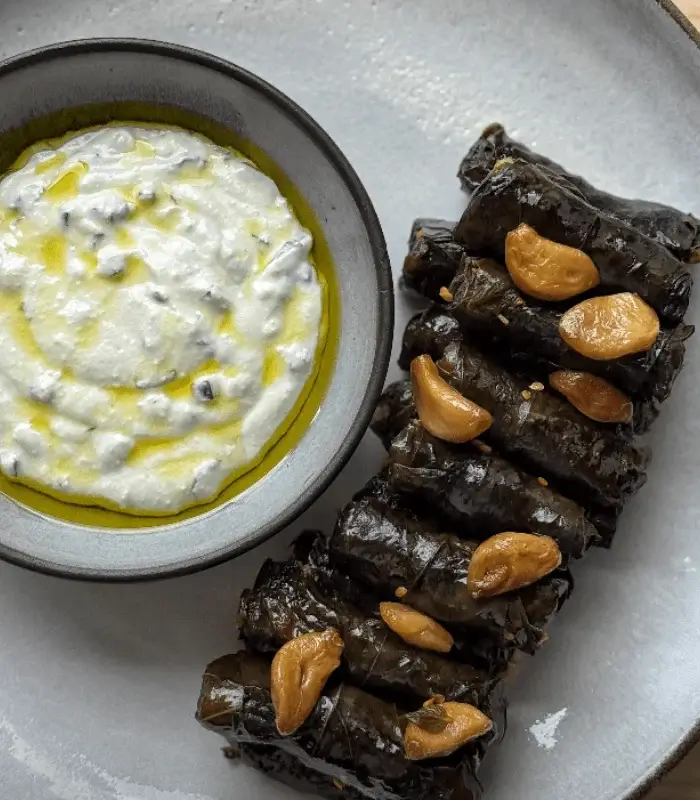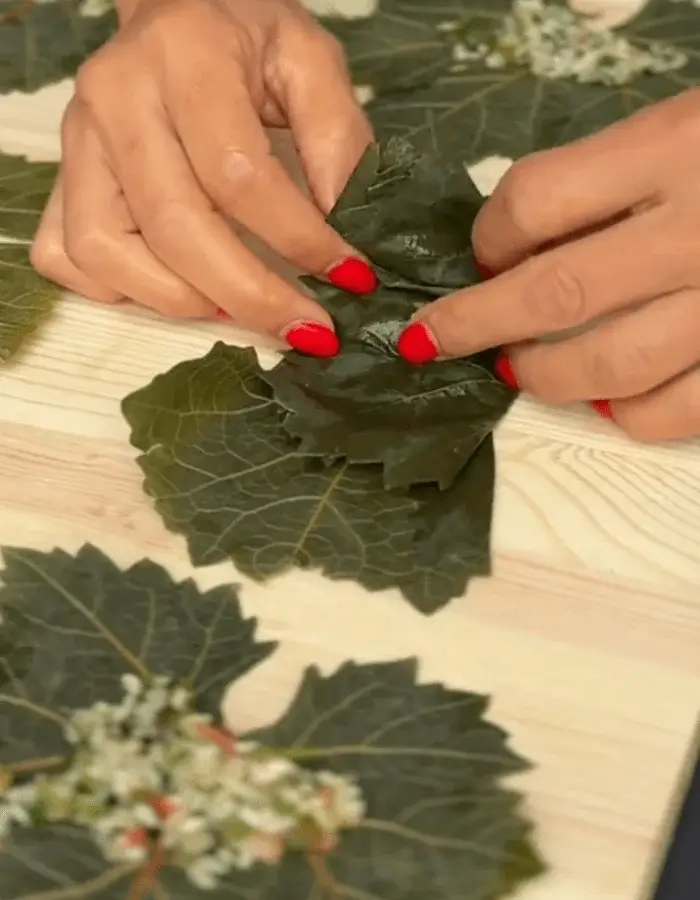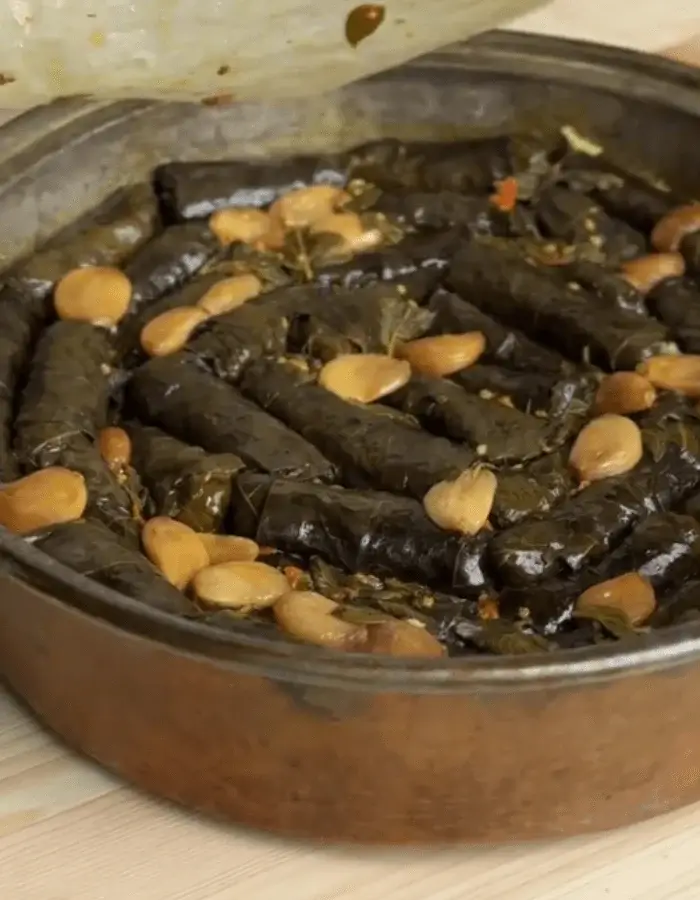Greek Grape Leaves Stuffed with Herbed Rice
We may earn a commission from recommended products, at no extra cost to you. See Disclosure.
- Large mixing bowl
- Sauté pan
- Chef's knife
- Blender
- Heatproof plate for weighting
INGREDIENTS
- 50 fresh grape leaves, blanched (or frozen and thawed)
- 2 cups/400 grams short-grain rice
- 1 cup parsley, finely chopped
- 1 cup dill, finely chopped
- A handful fresh mint leaves, finely chopped
- 2 onions, finely chopped
- 2 medium tomatoes, grated or pureed
- 1/4 cup olive oil, plus more for drizzling
- 1 teaspoon salt, or to taste
- Juice of 2 lemons
- 4 medium tomatoes, crushed
- 4 slices tomato, for lining the pot
- 1 tablespoon fresh zaatar leaves or a small sprig of thyme
- 4 cloves confit garlic, optional
- Water, as needed to cover
- Tzatziki:
- 1 cup/250 grams Greek yogurt
- 2 small cucumbers, peeled, seeded and diced
- 6 fresh mint leaves, finely chopped
- Juice of 1/2 lemon
- 2 tablespoons olive oil
- Salt and ground black pepper, to taste
INSTRUCTIONS
- Heat 1 tablespoon of the olive oil in a skillet over medium heat. Add the onions and cook, stirring occasionally, until soft and golden, 8 to 10 minutes. Let cool slightly.
- In a large bowl, combine the rice, sautéed onions, grated tomato, parsley, dill, mint, lemon juice, remaining olive oil and salt. Mix thoroughly.
- Place a grape leaf on a clean surface, shiny side down. Spoon about 1 heaping teaspoon of filling onto the base of the leaf. Fold the bottom up over the filling, then fold in the sides and roll tightly to form a cigar shape. Repeat with the remaining leaves and filling.
- Line the bottom of a wide, heavy pot with tomato slices. Arrange the grape leaves seam-side down in snug concentric circles. If needed, make a second layer. Sprinkle with za’atar and add the garlic, if using.
- Spoon the crushed tomatoes evenly over the rolls. Pour in just enough water to cover. Drizzle with a bit more olive oil and lemon juice. Place a sheet of parchment paper directly over the grape leaves and weigh them down with a heatproof plate. Cover with a lid or foil.
- Bring to a gentle boil over medium heat. Reduce the heat to low and simmer for 1 1/2 hours, or until the rice is fully cooked and the leaves are tender. Let cool in the pot.
- To make the tzatziki, stir together the yogurt, cucumbers, mint, lemon juice, olive oil, salt and pepper in a bowl. Chill until ready to serve.
- Serve the grape leaves warm, at room temperature or chilled, with tzatziki on the side.

FAQ
How can I keep the leaves from falling apart during cooking?
Make sure to roll them tightly but not too tight, as the rice will expand slightly. Always place them seam-side down in the pot to help them stay closed. Lining the pot with tomato slices and packing the rolls close together prevents them from moving during simmering. Covering them with parchment and a plate creates gentle pressure that holds them intact. Also, use high-quality grape leaves with no tears or holes, and blanch them first if they’re fresh to soften them for rolling.

Can I make these Greek grape leaves ahead of time?
You can be made ahead of time and actually improve in flavor after resting. Once cooked, let them cool completely, then refrigerate them in an airtight container for up to 5 days. You can serve them cold or at room temperature. If making in advance, store the tzatziki separately and add just before serving. For best texture, avoid freezing them after rolling and cooking, as the grape leaves can become rubbery when thawed. Prepare all the components the day before if you’re planning for a party or meal prep.
What kind of rice works best for Greek grape leaves?
Short-grain rice works best because it becomes tender but still cohesive after cooking. It absorbs the flavor of the herbs, tomatoes, and lemon without breaking apart. Avoid long-grain varieties like basmati, which can become too fluffy and separate. Arborio rice is a good substitute if short-grain rice isn’t available. Rinse the rice before using to remove excess starch, which helps keep the filling light and prevents it from becoming sticky inside the grape leaves during simmering.
Best way to store leftover Greek grape leaves
Store them in an airtight container in the refrigerator for up to 5 days. If they’re tightly packed and covered with a bit of the cooking liquid or olive oil, they’ll stay moist. You can enjoy them cold, straight from the fridge, or bring them to room temperature before serving. Reheating isn’t necessary for vegetarian versions. If serving warm, do so gently—steam briefly or microwave with a splash of water and cover to avoid drying out the rice.
How do I prevent the rice from being undercooked or mushy?
Start by rinsing the rice thoroughly to remove excess starch. Don’t pre-cook the rice—use it raw in the filling. Simmer gently and slowly, making sure the grape leaves are fully submerged and weighted down. Check the water level during cooking and add more if needed. Use short-grain rice, which holds together well but becomes tender. Avoid overpacking the rolls, which can trap steam and prevent even cooking.

Can I use jarred grape leaves?
Sure. Rinse them well under cold water to remove brine and soak them in hot water for 10 to 15 minutes to soften and remove excess salt. Trim any tough stems before using. While fresh grape leaves have a more delicate texture and herbal aroma, jarred leaves work well and are available year-round. Look for brands with whole, unbroken leaves packed in brine, not vinegar, for the most authentic flavor.
Are Greek grape leaves served hot or cold?
They can be served hot, warm, or cold depending on the occasion. Vegetarian versions like these, filled with herbed rice and no meat, are often served at room temperature or chilled as part of a mezze spread. If you serve them warm, do so shortly after cooking while still tender. They pair well with tzatziki, lemon wedges, and olives regardless of temperature. Leftovers are best enjoyed cold from the fridge, as the flavors deepen and the texture improves after a few hours of resting.
Can I substitute other herbs in Greek grape leaves?
Dill and mint are traditional, but flat-leaf parsley is essential for freshness. If dill isn’t available, you can try fennel fronds or a small amount of tarragon for a subtle anise note. If you’re out of mint, lemon balm or even a little basil can offer brightness. Be careful not to overpower the filling—these leaves are meant to taste light, clean, and herbaceous.
Can Greek grape leaves be frozen before or after cooking?
Freezing Greek grape leaves is possible, but best done after cooking. Let them cool completely, then wrap tightly in foil or place in an airtight container. Freeze for up to 2 months. Thaw overnight in the fridge and serve at room temperature or reheat gently. Freezing before cooking is less ideal because the rice absorbs moisture differently when thawed, often resulting in uneven texture. If freezing raw, underfill slightly and pack tightly to reduce tearing during reheating.

